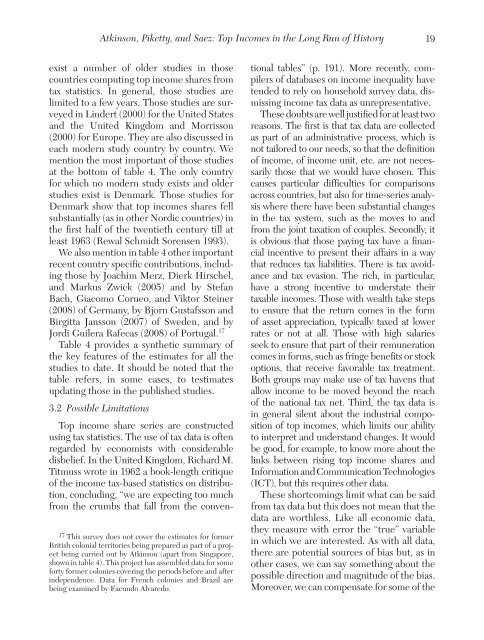"Top Incomes in the Long Run of History" with Tony Atkinson and
"Top Incomes in the Long Run of History" with Tony Atkinson and
"Top Incomes in the Long Run of History" with Tony Atkinson and
You also want an ePaper? Increase the reach of your titles
YUMPU automatically turns print PDFs into web optimized ePapers that Google loves.
Atk<strong>in</strong>son, Piketty, <strong>and</strong> Saez: <strong>Top</strong> <strong>Incomes</strong> <strong>in</strong> <strong>the</strong> <strong>Long</strong> <strong>Run</strong> <strong>of</strong> History19exist a number <strong>of</strong> older studies <strong>in</strong> thosecountries comput<strong>in</strong>g top <strong>in</strong>come shares fromtax statistics. In general, those studies arelimited to a few years. Those studies are surveyed<strong>in</strong> L<strong>in</strong>dert (2000) for <strong>the</strong> United States<strong>and</strong> <strong>the</strong> United K<strong>in</strong>gdom <strong>and</strong> Morrisson(2000) for Europe. They are also discussed <strong>in</strong>each modern study country by country. Wemention <strong>the</strong> most important <strong>of</strong> those studiesat <strong>the</strong> bottom <strong>of</strong> table 4. The only countryfor which no modern study exists <strong>and</strong> olderstudies exist is Denmark. Those studies forDenmark show that top <strong>in</strong>comes shares fellsubstantially (as <strong>in</strong> o<strong>the</strong>r Nordic countries) <strong>in</strong><strong>the</strong> first half <strong>of</strong> <strong>the</strong> twentieth century till atleast 1963 (Rewal Schmidt Sorensen 1993).We also mention <strong>in</strong> table 4 o<strong>the</strong>r importantrecent country specific contributions, <strong>in</strong>clud<strong>in</strong>gthose by Joachim Merz, Dierk Hirschel,<strong>and</strong> Markus Zwick (2005) <strong>and</strong> by StefanBach, Giacomo Corneo, <strong>and</strong> Viktor Ste<strong>in</strong>er(2008) <strong>of</strong> Germany, by Bjorn Gustafsson <strong>and</strong>Birgitta Jansson (2007) <strong>of</strong> Sweden, <strong>and</strong> byJordi Guilera Rafecas (2008) <strong>of</strong> Portugal. 17Table 4 provides a syn<strong>the</strong>tic summary <strong>of</strong><strong>the</strong> key features <strong>of</strong> <strong>the</strong> estimates for all <strong>the</strong>studies to date. It should be noted that <strong>the</strong>table refers, <strong>in</strong> some cases, to testimatesupdat<strong>in</strong>g those <strong>in</strong> <strong>the</strong> published studies.3.2 Possible Limitations<strong>Top</strong> <strong>in</strong>come share series are constructedus<strong>in</strong>g tax statistics. The use <strong>of</strong> tax data is <strong>of</strong>tenregarded by economists <strong>with</strong> considerabledisbelief. In <strong>the</strong> United K<strong>in</strong>gdom, Richard M.Titmuss wrote <strong>in</strong> 1962 a book-length critique<strong>of</strong> <strong>the</strong> <strong>in</strong>come tax-based statistics on distribution,conclud<strong>in</strong>g, “we are expect<strong>in</strong>g too muchfrom <strong>the</strong> crumbs that fall from <strong>the</strong> conven-17 This survey does not cover <strong>the</strong> estimates for formerBritish colonial territories be<strong>in</strong>g prepared as part <strong>of</strong> a projectbe<strong>in</strong>g carried out by Atk<strong>in</strong>son (apart from S<strong>in</strong>gapore,shown <strong>in</strong> table 4). This project has assembled data for someforty former colonies cover<strong>in</strong>g <strong>the</strong> periods before <strong>and</strong> after<strong>in</strong>dependence. Data for French colonies <strong>and</strong> Brazil arebe<strong>in</strong>g exam<strong>in</strong>ed by Facundo Alvaredo.tional tables” (p. 191). More recently, compilers<strong>of</strong> databases on <strong>in</strong>come <strong>in</strong>equality havetended to rely on household survey data, dismiss<strong>in</strong>g<strong>in</strong>come tax data as unrepresentative.These doubts are well justified for at least tworeasons. The first is that tax data are collectedas part <strong>of</strong> an adm<strong>in</strong>istrative process, which isnot tailored to our needs, so that <strong>the</strong> def<strong>in</strong>ition<strong>of</strong> <strong>in</strong>come, <strong>of</strong> <strong>in</strong>come unit, etc. are not necessarilythose that we would have chosen. Thiscauses particular difficulties for comparisonsacross countries, but also for time-series analysiswhere <strong>the</strong>re have been substantial changes<strong>in</strong> <strong>the</strong> tax system, such as <strong>the</strong> moves to <strong>and</strong>from <strong>the</strong> jo<strong>in</strong>t taxation <strong>of</strong> couples. Secondly, itis obvious that those pay<strong>in</strong>g tax have a f<strong>in</strong>ancial<strong>in</strong>centive to present <strong>the</strong>ir affairs <strong>in</strong> a waythat reduces tax liabilities. There is tax avoidance<strong>and</strong> tax evasion. The rich, <strong>in</strong> particular,have a strong <strong>in</strong>centive to understate <strong>the</strong>irtaxable <strong>in</strong>comes. Those <strong>with</strong> wealth take stepsto ensure that <strong>the</strong> return comes <strong>in</strong> <strong>the</strong> form<strong>of</strong> asset appreciation, typically taxed at lowerrates or not at all. Those <strong>with</strong> high salariesseek to ensure that part <strong>of</strong> <strong>the</strong>ir remunerationcomes <strong>in</strong> forms, such as fr<strong>in</strong>ge benefits or stockoptions, that receive favorable tax treatment.Both groups may make use <strong>of</strong> tax havens thatallow <strong>in</strong>come to be moved beyond <strong>the</strong> reach<strong>of</strong> <strong>the</strong> national tax net. Third, <strong>the</strong> tax data is<strong>in</strong> general silent about <strong>the</strong> <strong>in</strong>dustrial composition<strong>of</strong> top <strong>in</strong>comes, which limits our abilityto <strong>in</strong>terpret <strong>and</strong> underst<strong>and</strong> changes. It wouldbe good, for example, to know more about <strong>the</strong>l<strong>in</strong>ks between ris<strong>in</strong>g top <strong>in</strong>come shares <strong>and</strong>Information <strong>and</strong> Communication Technologies(ICT), but this requires o<strong>the</strong>r data.These shortcom<strong>in</strong>gs limit what can be saidfrom tax data but this does not mean that <strong>the</strong>data are worthless. Like all economic data,<strong>the</strong>y measure <strong>with</strong> error <strong>the</strong> “true” variable<strong>in</strong> which we are <strong>in</strong>terested. As <strong>with</strong> all data,<strong>the</strong>re are potential sources <strong>of</strong> bias but, as <strong>in</strong>o<strong>the</strong>r cases, we can say someth<strong>in</strong>g about <strong>the</strong>possible direction <strong>and</strong> magnitude <strong>of</strong> <strong>the</strong> bias.Moreover, we can compensate for some <strong>of</strong> <strong>the</strong>















